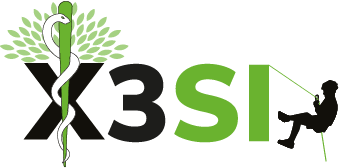Notes and revision resources for Module 10A – Life Support.
This module includes information on safe approach to a first aid scene, primary survey, ABC assessment, CPR for adults and children, using an AED, choking, unresponsiveness and the recovery position.
Basic Premise of Life Support
- We need the gasses (air) to come in and out
- We need the blood to go round and round
- We need the brain to send the signals that make these things happen
Anything which stands in the way of this is an immediate life threat.
Primary Assessment
- D– Danger
- R– Response (A or VPU)
- S– Severe bleeding, Spine, Send for help
- A– Airway
- B– Breathing
- C– Circulation
- D– Defibrillation (if not breathing normally)
High Quality CPR
- Right location – centre of the sternum
- Right rate – 100-120 compressions per minute
- Right depth – 1/3rd of the patient’s chest
- Minimal interruptions – Maximum 10 seconds, including applying AED pads and performing breaths
- Allow full recoil between compressions (allows the heart to refill with blood, so when you compress the heart again it empties out into the systemic circulation, carrying much needed oxygen to all the cells.
- Breaths delivered over 1 second
- Chest rise and fall, not stomach rise and fall
- If the chest does not rise and fall, reposition the airway and try again
Differences Between Adult and Child CPR
- Start with 5 rescue breaths, as the cause is statistically likely to be respiratory in nature
- Use your dominant hand only, not two hands as per adult CPR
- Other considerations for high quality CPR remain unchanged
COVID-19 Considerations
Place a towel or item of clothing across the patient’s mouth and nose to help prevent the spread of respiratory droplets
- Assess the patient’s respiratory status from an arms-length away
Below, you will find a couple of video links on practical skills we discussed on our call. These are a great resource to revise, and I thoroughly recommend going through them prior to validating with your TA, and also prior to attending a practical skills session.
CPR & AED Demo
Recovery Position
Any time you need to leave an unresponsive patient unattended (which you should only do if absolutely necessary, they should be placed in the recovery position. This helps them control their airway, and help any vomit drain from their mouth should they vomit. An unresponsive patient who is breathing normally and has no MOI indicating spinal injury should also be placed in this position. In all cases, a patient who is VPU on AVPU should be monitored closely.
Choking
Don’t forget to get behind the casualty and get your foot between their legs, so that if they do become unresponsive, you’re in a position to gracefully lower them to the ground, preventing them from falling and injuring themselves. Chest thrusts replace abdominal thrusts for pregnant people, infants and those who are you cannot reach around to perform an abdominal thrust. Chest thrusts are done much the same way, with your arms around the casualty, but up under their armpits, with the thrust being performed against the casualty’s sternum.
A quick reminder, in order to fully validate module 10, there are 4 steps:
- Module 10A Part 1 – Life Support (Video Call)
- Module 10A Part 2 – Trauma & Injury (Video Call)
- Module 10A Part 3 – Major Illness (Video Call)
- Module 10B – Practical Skills Session
If you ever have any questions about first aid, or if you have an incident and want to debrief, I’m happy to jump on a call with you. You can reach me via my BSO email address, or on WhatsApp (phone number is on the contact page). Do remember I’m in GMT+8 so am unlikely to be online during the evenings GMT/CET.
